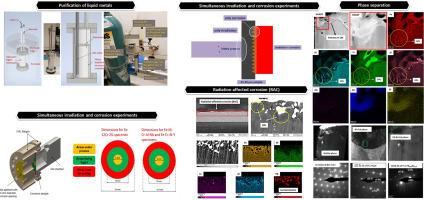Behavior of Fe-Based Alloys in a Liquid Lead-Bismuth Environment under Simultaneous Proton Irradiation and Corrosion
IF 8.3
1区 材料科学
Q1 MATERIALS SCIENCE, MULTIDISCIPLINARY
引用次数: 0
Abstract
The performance and longevity of nuclear reactors are significantly influenced by the behavior of their structural materials, particularly under conditions of corrosion and irradiation. This study investigates the combined effects of corrosion and irradiation on three alloys: Fe-Ni-Cr-Al-Nb, Fe-Cr-Al-Y, and Fe-12Cr-2Si, exposed to a liquid Pb-4wt% Bi mixture at 675°C for 4 hours. 3 MeV proton irradiation was employed to understand the simultaneous effects of irradiation on the corrosion behavior of these alloys. When exposed to liquid lead-bismuth at 675°C for 4 hours, the Fe-Cr-Al-Y and Fe-12Cr-2Si alloys exhibited superior corrosion resistance compared to the Fe-Ni-Cr-Al-Nb alloy. Conversely, the Fe-Ni-Cr-Al-Nb alloy demonstrated significant Pb-Bi penetration, which was further accelerated by proton irradiation, resulting in increased penetration depth. This revealed that irradiation-induced damage can accelerate the corrosion rate of Fe-Ni-Cr-Al-Nb steel in lead-bismuth environments. Microstructural analysis using SEM/EDX, STEM, and diffraction patterns uncovered complex alloy interactions and potential chemical transformations in the irradiated Fe-Ni-Cr-Al-Nb alloy. This included the presence of lamellar or rod-like structures near Pb-Bi penetration sites and the selective retention of nickel by aluminum. In contrast, the Fe-12Cr-2Si alloy exhibited effective corrosion resistance attributed to a uniform distribution of elements and the formation of a protective Si-rich oxide layer. The Fe-Cr-Al-Y alloy developed distinct oxide layers, with chromium oxide predominating and a slight aluminum oxide layer, indicating the critical role of chromium oxide as a protective barrier.

铅铋液态环境中的铁基合金在质子辐照和腐蚀同时作用下的行为
核反应堆的性能和寿命在很大程度上受到其结构材料行为的影响,尤其是在腐蚀和辐照条件下。本研究调查了腐蚀和辐照对三种合金的综合影响:Fe-Ni-Cr-Al-Nb、Fe-Cr-Al-Y 和 Fe-12Cr-2Si,在 675°C 下暴露于液态 Pb-4wt% Bi 混合物中 4 小时。为了了解辐照对这些合金腐蚀行为的同步影响,采用了 3 MeV 质子辐照。当暴露在 675°C 的液态铅铋中 4 小时时,与 Fe-Ni-Cr-Al-Nb 合金相比,Fe-Cr-Al-Y 和 Fe-12Cr-2Si 合金表现出更优异的耐腐蚀性。相反,Fe-Ni-Cr-Al-Nb 合金表现出明显的铅铋渗透,质子辐照进一步加速了这种渗透,导致渗透深度增加。这表明,辐照诱发的损伤可加快铅铋环境中 Fe-Ni-Cr-Al-Nb 钢的腐蚀速度。利用 SEM/EDX、STEM 和衍射图样进行的微观结构分析揭示了辐照铁-镍-脆-铝-铌合金中复杂的合金相互作用和潜在的化学转变。这包括在铅-铋穿透点附近出现的片状或棒状结构,以及铝对镍的选择性保留。相比之下,Fe-12Cr-2Si 合金则表现出有效的耐腐蚀性,这归功于元素的均匀分布和富含硅的氧化物保护层的形成。Fe-Cr-Al-Y 合金形成了明显的氧化层,其中氧化铬占主导地位,氧化铝层较少,这表明氧化铬作为保护屏障的关键作用。
本文章由计算机程序翻译,如有差异,请以英文原文为准。
求助全文
约1分钟内获得全文
求助全文
来源期刊

Acta Materialia
工程技术-材料科学:综合
CiteScore
16.10
自引率
8.50%
发文量
801
审稿时长
53 days
期刊介绍:
Acta Materialia serves as a platform for publishing full-length, original papers and commissioned overviews that contribute to a profound understanding of the correlation between the processing, structure, and properties of inorganic materials. The journal seeks papers with high impact potential or those that significantly propel the field forward. The scope includes the atomic and molecular arrangements, chemical and electronic structures, and microstructure of materials, focusing on their mechanical or functional behavior across all length scales, including nanostructures.
 求助内容:
求助内容: 应助结果提醒方式:
应助结果提醒方式:


